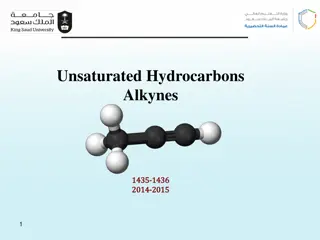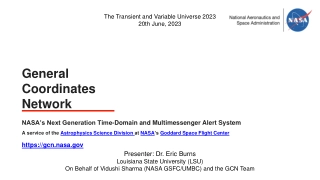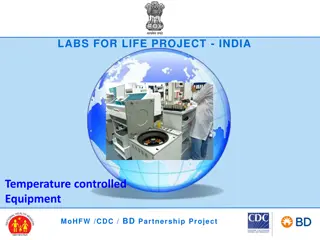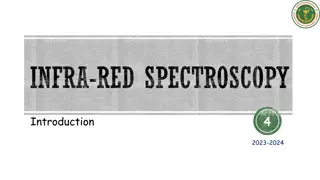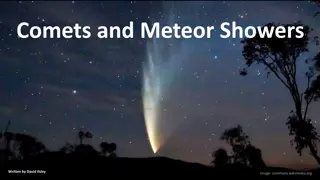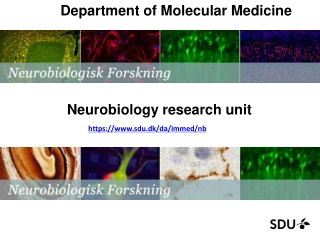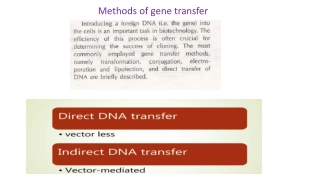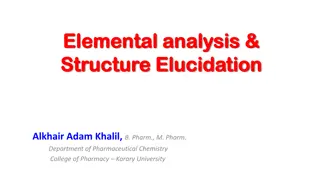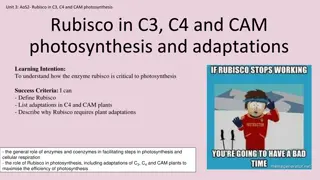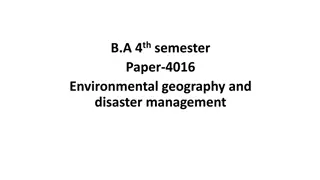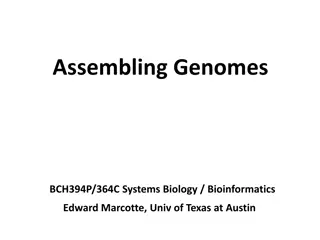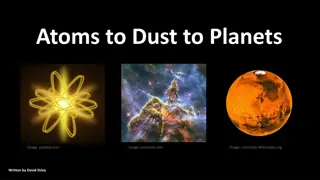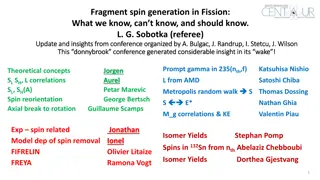Chemically-controlled Cosmos: Insights into Molecular Complexity in Astrophysical Environments
Delve into the intriguing world of the Chemically-controlled Cosmos, where spectroscopic observations reveal over 200 chemical species existing in gas and solid phases. From simple atoms and molecules to complex structures crucial for star formation and potential life seeding, explore the diverse environments supporting chemistry and physics in astrophysical settings. Discover how molecules play a vital role in maintaining star formation rates, fostering the birth of stars like our Sun, and contributing to the cosmic chemical landscape.
Download Presentation
Please find below an Image/Link to download the presentation.
The content on the website is provided AS IS for your information and personal use only. It may not be sold, licensed, or shared on other websites without obtaining consent from the author. Download presentation by click this link. If you encounter any issues during the download, it is possible that the publisher has removed the file from their server.
Presentation Transcript
Tools for In Operando Laboratory Astrophysics of Solids and Surfaces How Nanometre Physics and Chemistry Controls Exametre Physics and Chemistry Martin McCoustra Institute of Chemical Sciences, School of Engineering and Physical Sciences, Heriot-Watt University
The Chemically-controlled Cosmos Diffuse ISM NGC 3603 W. Brander (JPL/IPAC), E. K. Grebel (University of Washington) and Y. -H. Chu (University of Illinois, Urbana- Champaign) Dense Clouds Star and Planet Formation (Conditions for Evolution of Life and Sustaining it) Stellar Evolution and Death Institute of Chemical Sciences, School of Engineering and Physical Sciences, Heriot-Watt University
The Chemically-controlled Cosmos Spectroscopic observations have found over 200 different types of chemical species in the gas and solid phases Atoms, Radicals and Ions, e.g. H, N, O, , OH, CH, CN, , H3+, HCO+, ... Simple Molecules, e.g. H2, CO, H2O, CH4, NH3, Complex Molecules, e.g. HCN, CH3CN, CH3OH, C2H5OH, CH3COOH, (CH3)2CO, glycine, other amino acids and prebiotic molecules(?) Institute of Chemical Sciences, School of Engineering and Physical Sciences, Heriot-Watt University
The Chemically-controlled Cosmos Molecules are found in many regions but the most complex are observed in the dense regions, which are themselves known to be sites of star and planet formation Molecules are crucial for Maintaining the current rate of star formation Ensuring the formation of small, long-lived stars such as our own Sun Seeding the Universe with the chemical potential for life Institute of Chemical Sciences, School of Engineering and Physical Sciences, Heriot-Watt University
The Chemically-controlled Cosmos Different environments support different conditions in which chemistry and physics might occur Diffuse Medium Dense Medium Stellar Nebulae Proto- planetary Disks (Proto-) Planetary Atmospheres < 10-14 < 100 < 10-9 > 10 IR to Radio with CR VUV 103 - 104 < 0.1 20 - 100 UV to Radio with CR VUV 102 - 103 1 100 100 - 200 UV to Radio with CR VUV 10 - 100 > 1000 200 - 600 UV to Radio with CR VUV 0.01 - 10 Pressure / mbar Temperature / K Radiation / nm X-ray to Radio H / H+ Only H2 : CO Add in dust (silicaceous and carbonaceous) to this mix to provide surfaces for physics and chemistry Institute of Chemical Sciences, School of Engineering and Physical Sciences, Heriot-Watt University
The Chemically-controlled Cosmos Gas involving reactions and some types of reactions involving radicals go a long way to explain what we see in all environments phase chemistry ion-molecule free Adapted from Fraser, McCoustra & Williams, Astronomy and Geophysics, 2002, 43( Issue 2), 210. Institute of Chemical Sciences, School of Engineering and Physical Sciences, Heriot-Watt University
The Chemically-controlled Cosmos But ... Building chemical models of the evolution of space environments, such a dense gas clouds, involves networks of the 100s to 1000s of reactions and these often still fail to reproduce the observed concentrations of certain simple molecular species such as H2 (the most abundant molecule in the Universe), H2O, ... Dust is the Key Ingredient Necessary to Solve This Issue! Institute of Chemical Sciences, School of Engineering and Physical Sciences, Heriot-Watt University
The Chemically-controlled Cosmos H2 1 - 1000 nm H Icy Mantle Silicate or Carbonaceous Core H2O H3N H H CH4 CO, N2 O N CO, N2 Institute of Chemical Sciences, School of Engineering and Physical Sciences, Heriot-Watt University
The Chemically-controlled Cosmos 1 - 1000 nm Heat Input CH3NH2 CH3OH Icy Mantle Silicate or Carbonaceous Core NH3 H2O Thermal Desorption N2 CH4 CO2 CO Cosmic Ray Input Photodesorption Sputtering and Electron- stimulated Desorption UV Light Input Institute of Chemical Sciences, School of Engineering and Physical Sciences, Heriot-Watt University
The Chemically-controlled Cosmos Dust is crucial in many space environments; especially in cold dense environments Assists in the formation of small hydrogen-rich molecules including H2, H2O, CH4, NH3, ... some of which will be trapped as icy mantles on the grains Some molecules including CO, N2, ... can condense on the grains from the gas phase The icy grain mantle acts as a reservoir of molecules used to radiatively cool collapsing clouds as they warm Reactions induced by VUV photons and cosmic rays in these icy mantles can create complex, even pre-biotic molecules Institute of Chemical Sciences, School of Engineering and Physical Sciences, Heriot-Watt University
The Chemically-controlled Cosmos But we don t really know what grains look like graphenic, graphitic, silicate, crystalline, amorphous, ? Institute of Chemical Sciences, School of Engineering and Physical Sciences, Heriot-Watt University
Looking at Grain Surfaces Atoms (H, N, O, ), Radicals (CN, OH, CH, ) and Molecules UV Light and Electrons Mass Spectrometer Infrared for RAIRS Metal Substrate with Model Grain Overlayer Cool to Below 100 K Institute of Chemical Sciences, School of Engineering and Physical Sciences, Heriot-Watt University
Looking at Grain Surfaces H. J. Fraser, M. P. Collings and M. R. S. McCoustra, Rev. Sci. Instrum., 2002, 73, 2161 V. L. Frankland, A. Rosu-Finsen, J. Lasne, M. P. Collings, and M. R. S. McCoustra, Rev. Sci. Inst., 2015, 86, 055103 Institute of Chemical Sciences, School of Engineering and Physical Sciences, Heriot-Watt University
Looking at Grain Surfaces Amorphous silica (aSiO2) Produced by electron beam evaporation from solid silica on to a room temperature optically polished substrate Ideal for buried interface RAIRS Surface is polar! metal Laboratory Investigations of the Interaction between Benzene and Bare Silicate Grain Surfaces J. D. Thrower, M. P. Collings, F. J. M. Rutten and M. R. S. McCoustra, Mon. Not. R. Astron. Soc., 2009, 394, 1510 1518 Institute of Chemical Sciences, School of Engineering and Physical Sciences, Heriot-Watt University
Adsorption on Grain Surfaces Adsorption is the first process, we need to consider and so let s have a look at the adsorption of a few simple molecules like CO, H2O, or NH3 Institute of Chemical Sciences, School of Engineering and Physical Sciences, Heriot-Watt University
Adsorption on Grain Surfaces Chemical intuition would tell us dipolar molecules would absorb as in (a) Experimental measurement shows us (b) Institute of Chemical Sciences, School of Engineering and Physical Sciences, Heriot-Watt University
Depositing Dipolar Molecular Thin Films Still Don t Understand Why This Happens? Spontaneous Electric Fields in Solid Carbon Monoxide J. Lasne, A. Rosu-Finsen, A. Cassidy, M. R. S. McCoustra, and D. Field, Phys. Chem. Chem. Phys., 2015, 17, 30177-30187 Institute of Chemical Sciences, School of Engineering and Physical Sciences, Heriot-Watt University
Adsorption on Grain Surfaces Carbon monoxide, amorphous solid water, ammonia, methanol all show this behaviour at cryogenic temperatures and express a bulk electric fields up to 108 V/m Vibrational Stark Effect Surface Potentials We can express this in terms of z/ , the average dipole orientation perpendicular to the thin solid film Potentials increase with increasing film thickness Decrease with increasing deposition temperature Spontaneous Electric Fields in Solid Films: Spontelectrics D. Field, O. Plekan, A. Cassidy, R. Balog, N.C. Jones and J. Dunger, Int. Rev. Phys. Chem., 2013, 32, 345-392 A Review of Recent Progress in Understanding the Spontelectric State of Matter O. Plekan, A. Rosu-Finsen, A. M. Cassidy, J. Lasne, M. R. S. McCoustra and D. Field, Eur. Phys. J. D, 2017, 71, 162 Institute of Chemical Sciences, School of Engineering and Physical Sciences, Heriot-Watt University
So What with Spontelectric Ices? We have demonstrated that spontelectric behaviour in solid CO can be used to fill important gaps in our understanding of the evolution of pre-stellar cores Dust grains with a CO ice mantle reduce the degree of ionization of pre-stellar cores by a factor of between 5 and 6 This reduces the timescale for expulsion of magnetic fields from cores, a key step in promoting gravitational collapse, by a similar factor suggesting an explanation for the discrepancy between observed and calculated timescales for star formation Enabling Star Formation Via Spontaneous Molecular Dipole Orientation In Icy Solids A. Rosu-Finsen, J. Lasne, A. Cassidy, M. McCoustra and D. Field, Astrophys. J., 2016, 832, 1 Institute of Chemical Sciences, School of Engineering and Physical Sciences, Heriot-Watt University
Molecule Formation on Grain Surfaces Let now briefly consider how to make molecules on surfaces and to transform simple molecules into more complex species by reactions started by light or cosmic rays in icy solids Institute of Chemical Sciences, School of Engineering and Physical Sciences, Heriot-Watt University
Molecule Formation on Grain Surfaces Key aspects to consider Environment Cold and Dense versus Warm and Diffuse Substrates Silicaceous versus Carbonaceous versus Ices What do we need to measure? Reaction efficiencies and their temperature dependence Reaction mechanisms and dynamics including energy disposal Institute of Chemical Sciences, School of Engineering and Physical Sciences, Heriot-Watt University
Molecule Formation on Grain Surfaces H2 example Physisorption dominates H/D atom adsorption at low (< 20 K) temperatures Rates established using a combination of beam dosing of H/D atoms and TPD to follow Langmuir-Hinshelwood Mechanism on all surfaces Reaction is efficient enough to account for most of the H2 formation in environments formation is a nice G. Vidali, Chem. Rev., 2013, 113, 8762 cold, dense Institute of Chemical Sciences, School of Engineering and Physical Sciences, Heriot-Watt University
Molecule Formation on Grain Surfaces Total From TPD During Dosing HD recombination efficiency as a function of surface temperature HD TPD data as a function of H/D dosing time from 0.07 to 8 minutes Institute of Chemical Sciences, School of Engineering and Physical Sciences, Heriot-Watt University
Molecule Formation on Grain Surfaces H2 example formation is a nice Formation of the H-H bond releases something like 4.2 eV Dynamical studies substantial vibrational rotational excitation in the H2 product consistent dynamical simulations Key input to energy balance of the cold, dense regions and has prompted observational work looking for hot H2 reveal and with F. Islam, E. R. Latimer and S. D. Price, J. Chem. Phys., 2007, 127, 064701; J. L Lemaire, G. Vidali, S. Baouche, M. Chehrouri, H. Chaabouni and H. Mokrane, Astrophys. J., 2010, 725, L156 Institute of Chemical Sciences, School of Engineering and Physical Sciences, Heriot-Watt University
Molecule Formation on Grain Surfaces H2 example formation is a nice H2 formation also observed in warm, diffuse environments Formation likely chemisorbed graphitic/graphenic/PAH surfaces STM studies have established role of H2 dimers on the hexagonal carbon surface and agree with high quality DFT studies of these systems involves H/D on L. Hornek r, Z . Sljivancanin, W. Xu, R. Otero, E. Rauls, I. Stensgaard, E. L gsgaard, B. Hammer and F. Besenbacher, Phys. Rev. Lett., 2006, 96, 156104 Institute of Chemical Sciences, School of Engineering and Physical Sciences, Heriot-Watt University
Molecule Formation on Grain Surfaces The chemistry of cold, dense environments changes with time H atoms dominate the gas phase but efficient Early chemistry is dominated by hydride formation and H atom addition reactions Observe products chemistry directly from IR spectra of solids H2 formation (H2O, NH3, ) of that S. Ioppolo, H. M. Cuppen, E. F. van Dishoeck and H. Linnartz, Mon. Not. Roy. Astron. Soc., 2011, 410, 1089 Institute of Chemical Sciences, School of Engineering and Physical Sciences, Heriot-Watt University
Molecule Formation on Grain Surfaces The chemistry of cold, dense environments changes with time H2 dominates the gas phase Late chemistry associated with formation of complex organic molecules by radiation induced chemistry Observe products chemistry in the gas phase of that S. Maity, R. I. Kaiser and B. M. Jones, Faraday Discuss., 2014, 168, 485 Institute of Chemical Sciences, School of Engineering and Physical Sciences, Heriot-Watt University
Molecule Formation on Grain Surfaces Catalytic abundant in space and on grains (as single atoms and nanoclusters) Astrocatalysis Fischer-Tropsch and Haber- Bosch chemistries may be an important contributor chemical evolution in some denser and temperature environments elements are involving to higher Institute of Chemical Sciences, School of Engineering and Physical Sciences, Heriot-Watt University
Diffusion on and Desorption from Grains Then we need to understand how they are returned to the gas phase where they are most readily detected especially with the molecule hunting telescope ALMA Collisions Thermal Processes Non-Thermal (Light and Radiation Induced) Processes Institute of Chemical Sciences, School of Engineering and Physical Sciences, Heriot-Watt University
Collision-induced Diffusion and Desorption Collisions can promote diffusion Thermal energies (meV) at relevant temperatures are too small to induce desorption but may induce diffusion But it hasn t been studied! Collisions can promote desorption Super-thermal energies (meV few eV) can induce desorption and may be relevant in shocked regions Cosmic Ray energies from a few eV to TeV can induce chemical changes while above a few 100s of eV sputtering is common Grain-grain collisions? (single particle surface science?) Institute of Chemical Sciences, School of Engineering and Physical Sciences, Heriot-Watt University
Thermal Diffusion and Desorption Heating Activates diffusion and we need to understand diffusion as it is a the centre of the issue of whether adsorbates wet or de-wet from substrates Institute of Chemical Sciences, School of Engineering and Physical Sciences, Heriot-Watt University
Water Diffusion on Silica Water is a polar molecule it should wet the silica surface! But TPD shows zero order behaviour at all exposures consistent with de-wetting! Water does not wet the Silica Surface! Peeling the Astronomical Onion A. Rosu-Finsen, D. Marchione, T. L. Salter, J. W. Stubbing, W. A. Brown, and M. R. S. McCoustra, Phys. Chem. Chem. Phys., 2016, 18, 31930-31935 Institute of Chemical Sciences, School of Engineering and Physical Sciences, Heriot-Watt University
Water Diffusion on Silica A simple RAIRS experiment Fix temperature at 15 K Deposit quantity of H2O Anneal to 18 K and wait for an hour and cool to 15 K, record spectrum and repeat Intensity of O-H stretching band increases with time in a regime where there is no increase in the number of H2O on the surface! Agglomeration H2O and small clusters of H2O into bulk islands on the silica! sub-monolayer 0.007 0 ML H2O 0.5 ML H2O 1 hour 2 hours 3 hours 4 hours 5 hours A infinity 18 K 0.006 0.005 0.004 log( R0/R) 0.003 0.002 0.001 0.000 3600 3500 3400 3300 3200 3100 -1) Wavenumber (cm of isolated Institute of Chemical Sciences, School of Engineering and Physical Sciences, Heriot-Watt University
Water Diffusion on Silica First order kinetics analysis straight undergraduate laboratory Repeat at new temperature! Arrhenius analysis function of temperature T 25 K Ea 0 kJ mol-1 from the -6 -7 Ea 2 kJ mol-1 Avg of ln(k) -8 as a -9 annealing -10 -11 0.01 0.02 0.03 0.04 0.05 0.06 -1) 1/Temp (K Barrier to Agglomeration of 2 kJ/mol Below 25 K Institute of Chemical Sciences, School of Engineering and Physical Sciences, Heriot-Watt University
Benzene Diffusion on Silica Benzene molecule it should not wet the silica surface! But TPD shows a clear monolayer growing before the multilayer. is a non-polar Chemical Intuition Doesn t Work as Benzene Wets Silica Surface! Laboratory Investigations of the Interaction between Benzene and Bare Silicate Grain Surfaces J. D. Thrower, M. P. Collings, F. J. M. Rutten and M. R. S. McCoustra, Mon. Not. R. Astron. Soc., 2009, 394, 1510 1518 Institute of Chemical Sciences, School of Engineering and Physical Sciences, Heriot-Watt University
Cyclohexane Diffusion on Silica Cyclohexane is a non-polar molecule it should not wet the silica surface! TPD is consistent with de- wetting in showing zero order kinetics at all exposures. Chemical Intuition Works! R. Senevirathne, PhD Thesis (Heriot-Watt University, Edinburgh, in preparation) Institute of Chemical Sciences, School of Engineering and Physical Sciences, Heriot-Watt University
Adsorption and Diffusion A deeper perspective comes from modest ab initio calculations Silica clusters from work of Bromley and co-workers (Comp. Theo. Chem., 2017, 1102, 38-43) Simple HF calculations with 6.311G** basis using GAMESS-US EBSSE = -11.31 kJ/mol EBSSE = -75.77 kJ/mol Balance of Binding Energy to Surface and to Molecular Solid R. Senevirathne, PhD Thesis (Heriot-Watt University, Edinburgh, in preparation) Institute of Chemical Sciences, School of Engineering and Physical Sciences, Heriot-Watt University
Thermal Diffusion and Desorption Heating Activates diffusion Promotes thermal desorption Institute of Chemical Sciences, School of Engineering and Physical Sciences, Heriot-Watt University
An Example 160 K 135 - 140 K Temperature 30 - 70 K 10 - 20 K < 10 K M. P. Collings, H. J. Fraser, J. W. Dever, M. R. S. McCoustra and D. A. Williams Ap. J., 2003, 583, 1058-1062 Institute of Chemical Sciences, School of Engineering and Physical Sciences, Heriot-Watt University
An Example Constructed a kinetic model to describe which reproduces well our experimental observations. We are now using it in a predictive determine what happens at astronomically heating rates, i.e. A few 10s of pK s-1cf. 80 mK s-1 in our TPD studies Experiment this process manner to relevant Model Institute of Chemical Sciences, School of Engineering and Physical Sciences, Heriot-Watt University
An Example What do these observations mean to those modelling the chemistry of the interstellar medium? Assume Heating Rate of 1 K millennium-1 New Picture of CO Evaporation Old Picture of CO Evaporation 1.2 1.2 1 1.0 0.8 0.8 Fraction of CO Desorbed Fraction of CO Desorbed 0.6 0.6 0.4 0.4 0.2 0.2 0 0.0 0 25 50 75 100 125 0 25 50 75 100 125 Temperature / K Temperature / K Institute of Chemical Sciences, School of Engineering and Physical Sciences, Heriot-Watt University
Extending the Example Qualitative survey of TPD of grain mantle constituents Type 1 Hydrogen bonding materials, e.g. NH3, CH3OH, , which desorb only when the water ice substrate desorbs Type 2 Species where Tsub > Tpore collapse, e.g. H2S, CH3CN, , have a limited ability to diffuse and hence show only molecular desorption and do not trap when overlayered on water ice but exhibit largely trapping behaviour in mixtures Type 3 Species where Tsub < Tpore collapse, e.g. N2, O2, , readily diffuse and so behave like CO and exhibit four TPD features whether in overlayers or mixtures Type 4 Refractory materials, e.g. metals, sulfur, etc. desorb only at high temperatures (100s of C) H2O CH3OH OCS H2S CH4 N2 Institute of Chemical Sciences, School of Engineering and Physical Sciences, Heriot-Watt University
Non-Thermal Diffusion and Desorption What about Vibrational Excitation? Abundance of IR wavelengths in the interstellar radiation field Also more readily penetrates dense environments than shorter wavelengths Mid-IR photons have energies in excess of typical weak physisorption interaction and so should be able to promote diffusion and desorption Watch this Space! Institute of Chemical Sciences, School of Engineering and Physical Sciences, Heriot-Watt University
Non-Thermal Diffusion and Desorption What about Electronic Excitation? Photons Typically VUV (around 10 eV) but also visible as the maximum flux in the interstellar radiation field is in the visible Cosmic Rays and their secondary electrons Secondary electrons are the key to understanding Cosmic Ray effects on icy solids Of course each Cosmic Ray can produce many secondary electrons Need to measure both reaction efficiencies and their temperature dependence and reaction mechanisms and dynamics including energy disposal as the later is important in the environmental energy balance Institute of Chemical Sciences, School of Engineering and Physical Sciences, Heriot-Watt University
Shining a Little Light or Electrons Photon Induced Desorption Curves 1500 Mass 78 SEM counts/s 1000 Liquid N2 QMS 500 0 30 40 Time (s) Photon-induced Desorption trigger 6 MCS mcs counts 4 2 0 0.0 0.5 1.0 time-of-flight (ms) 1.5 2.0 2.5 3.0 3.5 4.0 Time of Flight (ToF) Institute of Chemical Sciences, School of Engineering and Physical Sciences, Heriot-Watt University
UV Photons Desorption Kinetics System studied, C6H6 on amorphous solid H2O Presence of C6H6 promotes H2O desorption Cross-section for the process can be estimated from PSD curves 1 10-19 cm2 at 250 nm cf. 4 10-19 cm2 for C6H6 itself Suggests an approaching 0.25! efficiency J. D. Thrower, A. G. M. Abdulgalil, M. P. Collings, M. R. S. McCoustra, D. J. Burke, W. A. Brown, A. Dawes, P. J. Holtom, P. Kendall, N. J. Mason, F. Jamme, H. J. Fraser, and F. J. M. Rutten, J. Vac. Sci. Technol. A., 2010, 28, 799. Institute of Chemical Sciences, School of Engineering and Physical Sciences, Heriot-Watt University
UV Photons Mechanism and Dynamics C6H6 observed wavelengths Substrate-mediated desorption dependent wavelength Adsorbate-mediated desorption absorption strength of C6H6 Yield of reduced presence of a H2O capping layer desorption at all weakly on reflects C6H6 by is the J. D. Thrower, M. P. Collings, M. R. S. McCoustra, D. J. Burke, W. A. Brown, A. Dawes, P. D. Holtom, P. Kendall, N. J. Mason, F. Jamme, H. J. Fraser, I. P. Clark and A. W. Parker, J. Vac. Sci. Technol. A, 2008, 26, 919. Institute of Chemical Sciences, School of Engineering and Physical Sciences, Heriot-Watt University
UV Photons Mechanism and Dynamics H2O echoes that of C6H6 But H2O does not absorb at any of these wavelengths and so desorption is mediated substrate C6H6 Yield of increased presence of a C6H6 layer desorption via and the the H2O by is the Institute of Chemical Sciences, School of Engineering and Physical Sciences, Heriot-Watt University
Secondary Electrons Desorption Kinetics C6H6 on amorphous solid H2O were irradiated with electrons of between 100 and 400 eV Desorption of C6H6 mediated by the H2O ice and the formation of excitons Desorption of C6H6 diffusing between islands massive cross-section around 2 10-15 cm2 in this range cf. 5 10-18 cm2 for H2O We see no evidence for any chemical transformations only desorption energies of has a of J. D. Thrower, M. P. Collings, F. J. M. Rutten, and M. R. S. McCoustra, Chem. Phys. Lett., 2011, 505, 106-111 Institute of Chemical Sciences, School of Engineering and Physical Sciences, Heriot-Watt University
Secondary Electrons Mechanism Hint of a fast desorption from CH3OH (red) Linear hydrogen bonded chains CH3OH has no dangling OH groups at the surface so CH3OH must re- orientate on surface if C6H6 is to hydrogen bond to the surface and the long time rise in signal is probably due to that! No evidence for fast process on (CH3CH2)2O (blue) No intermolecular hydrogen bonding C6H6 interacts with the (CH3CH2)2O via van der Waals forces Hydrogen bonding is crucial! Institute of Chemical Sciences, School of Engineering and Physical Sciences, Heriot-Watt University





